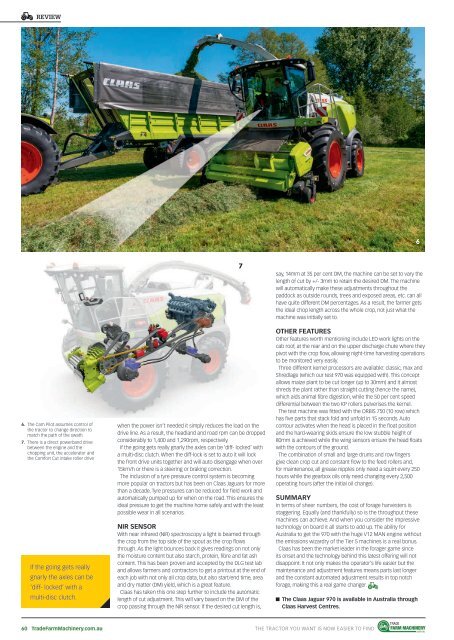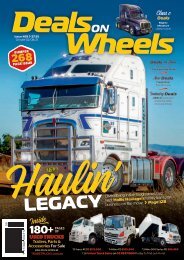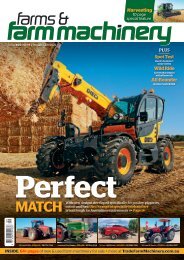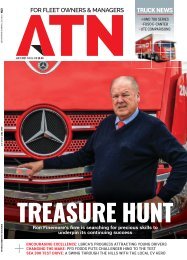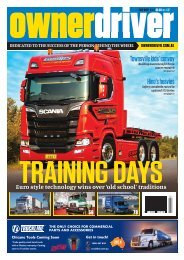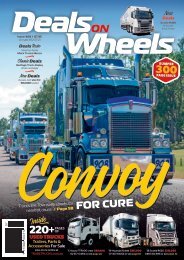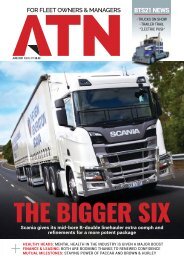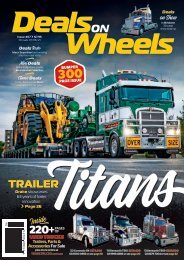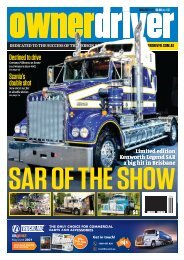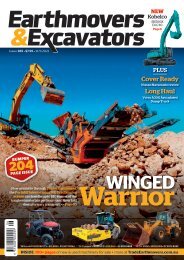Create successful ePaper yourself
Turn your PDF publications into a flip-book with our unique Google optimized e-Paper software.
REVIEW<br />
6<br />
6. The Cam Pilot assumes control of<br />
the tractor to change direction to<br />
match the path of the swath<br />
7. There is a direct powerband drive<br />
between the engine and the<br />
chopping unit, the accelerator and<br />
the Comfort Cut intake roller drive<br />
If the going gets really<br />
gnarly the axles can be<br />
‘diff- locked’ with a<br />
multi-disc clutch.<br />
when the power isn’t needed it simply reduces the load on the<br />
drive line. As a result, the headland and road rpm can be dropped<br />
considerably to 1,400 and 1,290rpm, respectively.<br />
If the going gets really gnarly the axles can be ‘diff- locked’ with<br />
a multi-disc clutch. When the diff-lock is set to auto it will lock<br />
the front drive units together and will auto disengage when over<br />
15km/h or there is a steering or braking correction.<br />
The inclusion of a tyre pressure control system is becoming<br />
more popular on tractors but has been on Claas Jaguars for more<br />
than a decade. Tyre pressures can be reduced for field work and<br />
automatically pumped up for when on the road. This ensures the<br />
ideal pressure to get the machine home safely and with the least<br />
possible wear in all scenarios.<br />
NIR SENSOR<br />
With near infrared (NIR) spectroscopy a light is beamed through<br />
the crop from the top side of the spout as the crop flows<br />
through. As the light bounces back it gives readings on not only<br />
the moisture content but also starch, protein, fibre and fat ash<br />
content. This has been proven and accepted by the DLG test lab<br />
and allows farmers and contractors to get a printout at the end of<br />
each job with not only all crop data, but also start/end time, area<br />
and dry matter (DM) yield, which is a great feature.<br />
Claas has taken this one step further to include the automatic<br />
length of cut adjustment. This will vary based on the DM of the<br />
crop passing through the NIR sensor. If the desired cut length is,<br />
7<br />
say, 14mm at 35 per cent DM, the machine can be set to vary the<br />
length of cut by +/- 3mm to retain the desired DM. The machine<br />
will automatically make these adjustments throughout the<br />
paddock as outside rounds, trees and exposed areas, etc. can all<br />
have quite different DM percentages. As a result, the farmer gets<br />
the ideal chop length across the whole crop, not just what the<br />
machine was initially set to.<br />
OTHER FEATURES<br />
Other features worth mentioning include LED work lights on the<br />
cab roof, at the rear and on the upper discharge chute where they<br />
pivot with the crop flow, allowing night-time harvesting operations<br />
to be monitored very easily.<br />
Three different kernel processors are available: classic, max and<br />
Shredlage (which our test 970 was equipped with). This concept<br />
allows maize plant to be cut longer (up to 30mm) and it almost<br />
shreds the plant rather than straight cutting (hence the name),<br />
which aids animal fibre digestion, while the 50 per cent speed<br />
differential between the two KP rollers pulverises the kernel.<br />
The test machine was fitted with the ORBIS 750 (10 row) which<br />
has five parts that stack fold and unfold in 15 seconds. Auto<br />
contour activates when the head is placed in the float position<br />
and the hard-wearing skids ensure the low stubble height of<br />
80mm is achieved while the wing sensors ensure the head floats<br />
with the contours of the ground.<br />
The combination of small and large drums and row fingers<br />
give clean crop cut and constant flow to the feed rollers and,<br />
for maintenance, all grease nipples only need a squirt every 250<br />
hours while the gearbox oils only need changing every 2,500<br />
operating hours (after the initial oil change).<br />
SUMMARY<br />
In terms of sheer numbers, the cost of forage harvesters is<br />
staggering. Equally (and thankfully) so is the throughput these<br />
machines can achieve. And when you consider the impressive<br />
technology on board it all starts to add up. The ability for<br />
Australia to get the 970 with the huge V12 MAN engine without<br />
the emissions wizardry of the Tier 5 machines is a real bonus.<br />
Claas has been the market leader in the forager game since<br />
its onset and the technology behind this latest offering will not<br />
disappoint. It not only makes the operator’s life easier but the<br />
maintenance and adjustment features means parts last longer<br />
and the constant automated adjustment results in top notch<br />
forage, making this a real game changer.<br />
The Claas Jaguar 970 is available in Australia through<br />
Claas Harvest Centres.<br />
60 Trade<strong>Farm</strong><strong>Machinery</strong>.com.au THE TRACTOR YOU WANT IS NOW EASIER TO FIND


